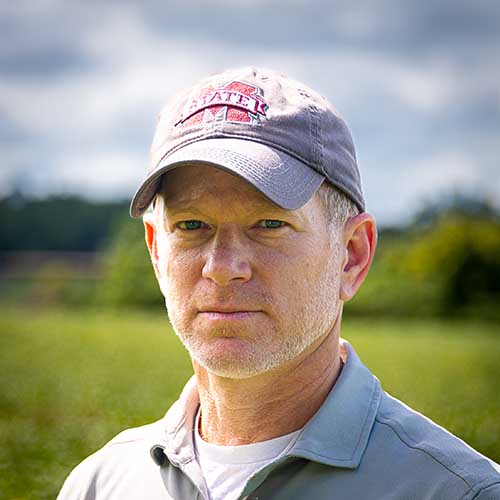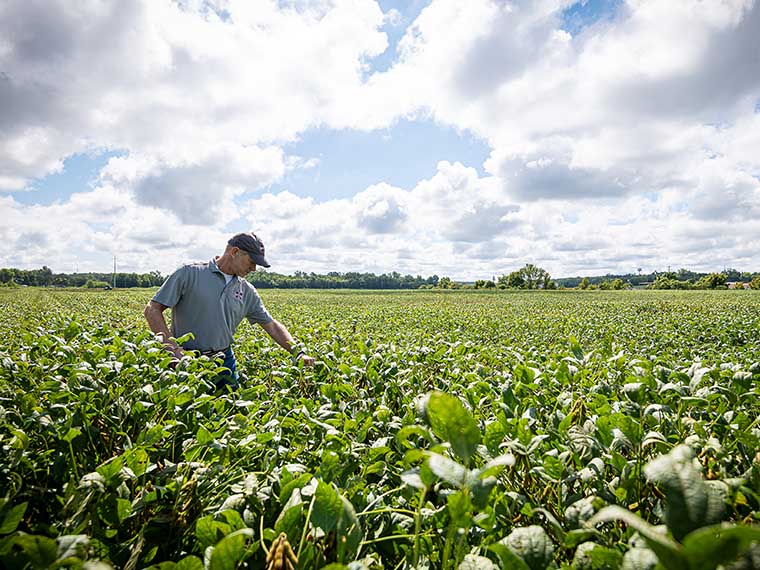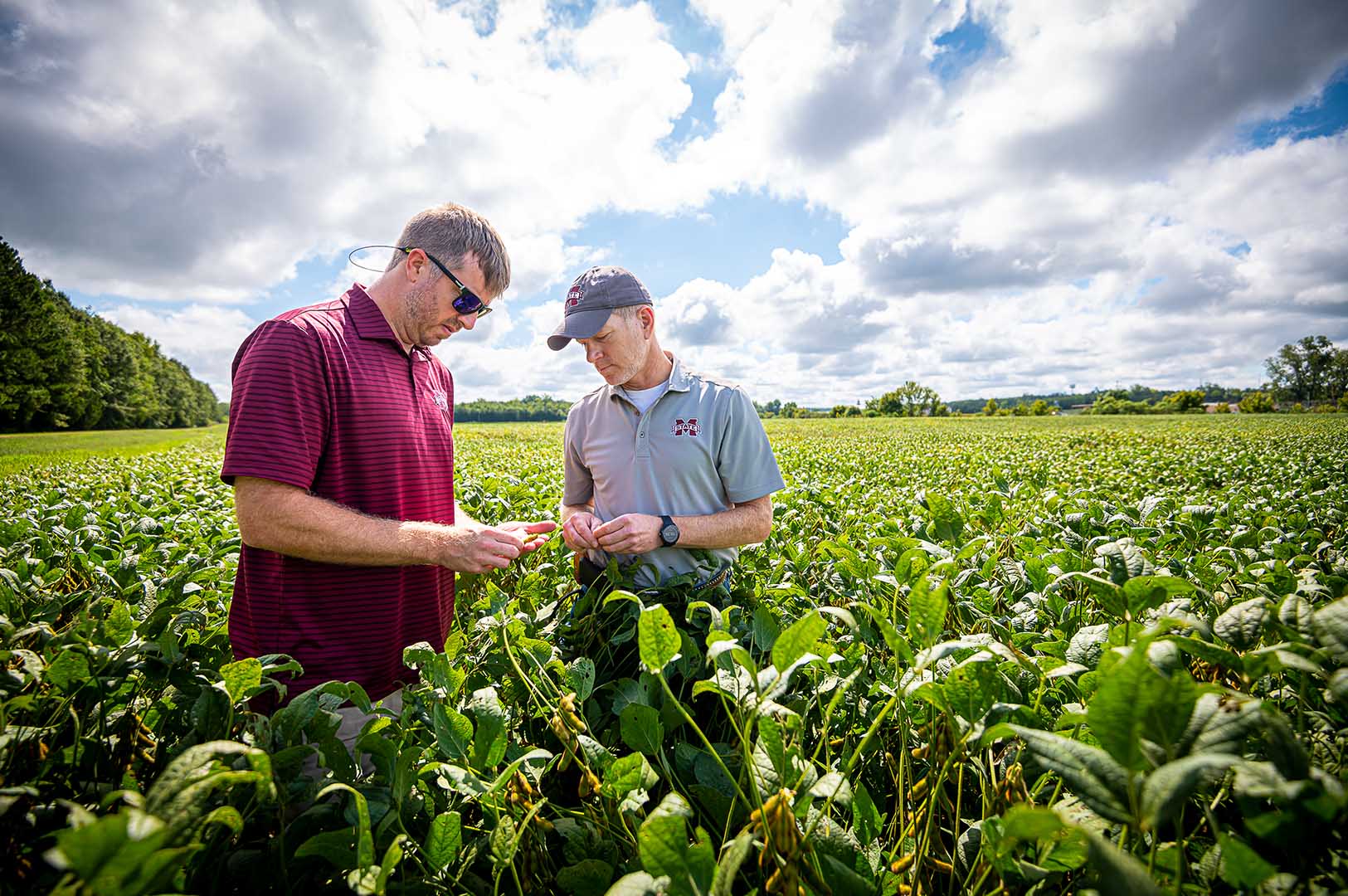The information presented on this page may be dated. It may refer to situations which have changed or people who are no longer affiliated with the university. It is archived as part of Mississippi State University's history.
Brought to the United States from China in the eighteenth century, the soybean occupies 75 million acres of U.S. land today. This versatile bean feeds the world and is also used in products such as upholstery, biodiesel fuel, and paint for roads and parking lots. In Mississippi, soybeans are the number one row crop and the second largest agricultural commodity, trailing poultry. To meet the world's needs for this crop, Mississippi farmers today look to technological advances that will maximize the quantity and quality of their yields.
In a study funded by the Mississippi Soybean Promotion Board, a team of MAFES scientists headed by Dr. Michael J. Mulvaney, Edgar E. and Winifred B. Hartwig Endowed Chair in Soybean Agronomy, and including Drs. Wes Lowe, Raju Rangappa, Corey Bryant, and Brian Mills, set out to test the accuracy of electronic planting technology at various speeds and determine return on investment. While the technology has been used in the Midwest, it is relatively new in the South. The researchers want to determine how the machinery operating at higher speeds impacts the yield and return on investment.
Traditionally, mechanical planters, which function best at slower speeds, have done the job, but due to narrow planting windows on poorly drained soils in Mississippi, speed is more of a necessity than a luxury. This is where advanced planting technology enters the picture.
"If we are able to plant at 10 miles per hour, for instance, we can cover twice the acreage than we can at 5 miles per hour," Mulvaney said. "At conventional speeds, if you only have a week to plant and 10,000 acres to cover, you're faced with the costs of buying another tractor and planter, plus the labor to run the additional equipment."
The team is conducting experiments at five different sites around the state, each with a different soil type: Starkville, Brooksville, Verona, and two sites in Stoneville with a clay soil and a silt loam soil. The planting speeds tested at each site ranged from 5 miles per hour to 10 miles per hour. The study is still in progress, however, emergence, stand count, and yield data look promising.
"The response across soil types seems to be fairly consistent," Mulvaney said. "As we pick up speed, we tend to get lower populations than at slower speeds, but the faster planting rate did not limit soybean yield."
Farmers typically plant more seeds than are needed to produce their target yields since only about 95 percent germinate, and some are lost to unanticipated events such as flooding or pests. In this study, the team populated the test sites with 123,000 seeds per acre, hoping for a stand of 117,000 plants per acre.
In theory, faster is better, but in practice, it is not so straightforward because of potential limitations of the planting machinery. The question that Mulvaney and his team have yet to explore is whether speeding up the planting process will not inadvertently cause a reduction of crop yields, and if the increased speed will pay for the cost of the technology. Initial harvest data indicate that yield was not harmed.
"Even if we lose some seeds when we increase the speed, we don't expect to get a yield hit until our populations are below 80,000," Mulvaney said.
"Our yield data indicates that faster planting did not affect harvest. The question then will be return on investment."
The Mississippi State Seed Testing Laboratory is evaluating the harvested soybean quality parameters.
Initial results also show that, at all sites, speed had little effect on the number of seeds that emerged, although a general decrease in plant stands with increasing speed was observed. There was also little difference in results between the mechanical planters and the electronic planters. Mulvaney warned, however, that the lack of differences among planters should be interpreted with caution, as planting large acreage with a mechanical planter at high speeds is likely to result in mechanical failure and costly field repairs.
"The test plots are only 150 to 200 feet long. If you ran a mechanical planter at 10 miles per hour over 10,000 acres, you would run a high risk of mechanical problems because these planters are not designed to move at high speeds over long periods of time," Mulvaney said.
In contrast, precision planters like Ag Leader's SureSpeed system, which was used in this study, do not have as many moving pieces as their mechanical counterparts, so they are less likely to break under stressful conditions. Precision planters are also more accurate at placing seeds in the ground. The design of the seed tube in a mechanical planter does not deliver seeds uniformly from seed tube to seed trench. In contrast, the design of precision planters delivers uniformly spaced seeds with consistency.
"The seed tube speeds up and slows down with the speed of the tractor. With advanced planting technology, the planter 'speaks' to the tractor, letting it know how much seed to deliver based on its goal output and the speed of the tractor. This is something that is not easily done with a mechanical planter," he said.
In addition to quantifying their efforts to increase efficiency and productivity in the field, the team also looks to assess the economic benefits of increasing planting speed. When the field research is complete, the team will conduct an economic analysis to determine the return on investment, or ROI, of this technology.
"The technology isn't cheap, so we need to know the cost per row of installing it and whether the savings in equipment and labor justify the purchase for farmers," Mulvaney said. "None of us want to recommend technology that will end up ultimately costing farmers money."
In the coming year, Mulvaney hopes to complete the picture by studying the technology through the entire agricultural cycle. With the necessary financial support, he hopes to add plant and soil sciences corn specialists Drs. Jagmandeep Dhillon, assistant professor, and Erick Larson, extension and research professor, to the project to study the technology on corn crops.
"In Mississippi, most farmers rotate soybean crops with corn. When we look at using this technology on both crops, we can get a better idea of the full impact on the cropping system in our state. If Mississippi farmers are going to adopt this technology, they'll want to know the total ROI for the entire cropping system," he said.
Mulvaney also hopes to conduct a future study on the potential of reducing seeding rates during planting, a move that, if effective, would likely result in significant savings to farmers.
"If we can accurately plant seeds at 10 miles per hour without losses to our crop yields, would it be possible to reduce our seeding rate without sacrificing yields?" Mulvaney asked. "We have to do the research to find out, but with these advanced planting technologies, we can now ask the question."
This research is funded by the Mississippi Soybean Promotion Board and Ag Leader.
Even if we lose some seeds when we increase the speed, we donít expect to get a yield hit until our populations are below 80,000.
Dr. Michael Mulvaney
Behind the Science

Mike Mulvaney
Associate Professor, Edgar E. and Winifred B. Hartwig Endowed Chair in Soybean Agronomy
Education: B.S., Chemistry, University of Connecticut; Ph.D., Agronomy and Soils, Auburn University
Years At MSU: 1
Focus: Soybean agronomy
Passion At Work: Identify and remove agronomic constraints to soybean production, ultimately improving production efficiencies.


